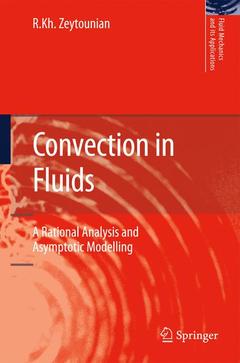(provisional) Preface and Acknowledgments 1 Short Preliminary Comments and Summary of Chapters 2 to 10 1 . 1 Introduction 1.2 Summary of the chapters 2 to 10 2 The Navier-Stokes and Fourier Problem 2. 1 Some relations of the thermodynamics 2.2 The case of a thermally perfect gas 2.3 The case of an expansible liquid 2.4 The NS-F starting problem 2.4.1 Equations 2.4.2 Initial and boundary conditions 2.5 SQme comments 3 The Simple Rayleigh (1916) Thermal Convection Problem 3. 1 Formulation of the exact simplified (a la Rayleigh) problem 3.2 Dimensionless dominant Rayleigh problem and the Boussinesq approximation 3.3 The Rayleigh-Bénard (RB), rigid-rigid, problem as a leading-order approximate model 3.4 Associated, to RB problem, second-order model problem 4 The Bénard (1900, 1901), Heated from Below, Convection Problem 4.1 The mathematical formulation of the full Bénard convection problem heated from below 4. 1 . 1 Bénard, basic motionless conduction, effect 4. 1 .2 Marangoni, temperature dependent surface tension, effect 4. 1 .3 Biot, heat flux through the upper surface, effect 4.4.4 Boussinesq, buoyancy, effect 4.2 Dimensionless analysis and reduced parameters 4.3 Dominant equations 4.4 Dominant boundary conditions 4.5 An ‘alternative’ 4.6 Three significant cases: 4.6. 1 Shallow convection 4.6.2 Deep convection 4.6.3 Marangoni convection 5 Thermal Shallow Convection Problem, ‘a la Rayleigh-Bénard’ 5. 1 The RB rigid-free instability problem as a significant leading-order model problem 5.2 The free surface, Marangoni and Biot effects 5.3 Second-order non Boussinesq and viscous dissipation effects 5.4 Linear classical theory 5.5 Some comments and complements 6 The Deep Thermal Convection Problem, 6. 1 The viscous dissipation effect and the ‘depth’ parameter 6.2 Thedeep thermal convection problem, ‘a la Zeytounian’ 6.3 The Charki, Errafyi and Zeytounian results: 6.3.1 Linear theory 6.3.2 Routes to chaos, 6.3.3 Lorenz system 6.3.4 Landau -Ginzburg equation 6 6.4 The Straughan and Charki rigorous mathematical results 6.5 The Hills and Roberts approach 7 The Thermocapilary, Marangoni, Convection Problem 7. 1 The free surface effects and the ‘ ‘Biot paradox' 7.2 The Bénard-Marangoni model problem 7.3 The long-wave approximation and the lubrication evolution equation for the thickness of the film 7.4 Freely falling vertical film 7.5 The KS and KS-KdV approximate equations 7 . 6 Stability results 7.7 Complements 8 Summing Up of the Three Cases Related with the Bénard, Heated from Below, Convection Problem 8. 1 The consistent conditions for the Rayleigh-Bénard model problem 8. 1 . 1 Constraints on the thickness of the fluid layer 8. 1 .2 The role of the viscous dissipation term 8. 1 .3 An equation for the free surface deformation 8.2 The particularity of the deep thermal convection model problem 8.2. 1 The role of the ‘depth’ parameter and the effect of the viscous dissipation 8.2.2 The variation of the critical Rayleigh numbers as a function of the depth parameter 8.3 The thin viscous liquid film, Marangoni, case 8.3.1 Constraints on the thickness of the liquid layer 8.3.2 The role of the free surface deformation 8.3..3 Constraints for a reduced long wave film problem 9 Atmospheric Thermal Convection Problems 9. 1 The Coriolis force and stratification effects 9.2 A rigorous formulation of the atmospheric free thermal convection 9.3 The Boussinesq approximation and the breeze problem 9.4 Infuence of a local temperature field in an atmospheric Ekman layer; a triple-deck approach 9.5 A periodic thermal free-convection problem over a curvilinear wall; the




